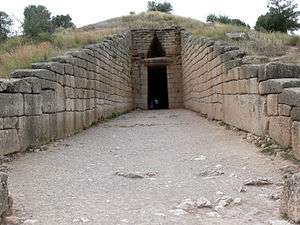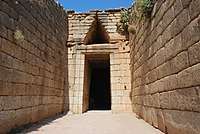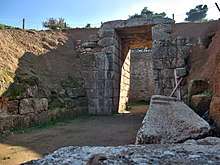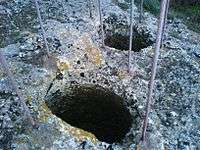Mycenaean chamber tomb
The Mycenaean chamber tomb is the type of chamber tomb that was built by ancient Mycenaeans. This form of mortuary architecture was in use in the Late Bronze Age in the areas under the cultural influence of the Aegean.

Treasury of Atreus, a 13th century BC Mycenaean, royal tholos, "beehive" chamber tomb in Mycenae, Greece

Corbelled arch of Treasury of Atreus chamber tomb

Cross-section interior diagram of the dome shape of the Treasury of Atreus tolos beehive type Mycenaean chamber tomb
The tombs are cut from rock and have a tripartite structure (chamber, stomion and dromos), often with additional niches and side chambers in which primary or secondary burials took place. Extensive cemeteries have been found in every part of Greece having Mycenaean influences, including the islands. Such tombs were also built in parts of ancient Anatolia. For about 500 years from 1600 BC to 1100 BC they were the most widespread of mortuary structures.
See also
- Mycenaean shaft tombs — from Early Bronze Age Greece.
- Tholoi
References
- W. Cavanagh and C. Mee, A Private Place: Death in Prehistoric Greece [SIMA 125] (Jonsered 1998)
- Early Burials from the Agora Cemeteries by Sara Anderson Immerwahr
- NARRATIVE: Mycenaean Tholos Tombs and Early Mycenaean Settlements dartmouth.edu/
- IMAGES: Mycenaean Tholos Tombs and Early Mycenaean Settlements dartmouth.edu/
- BIBLIOGRAPHY: Mycenaean Tholos Tombs and Early Mycenaean Settlements dartmouth.edu/
This article is issued from Wikipedia. The text is licensed under Creative Commons - Attribution - Sharealike. Additional terms may apply for the media files.

.jpg)
